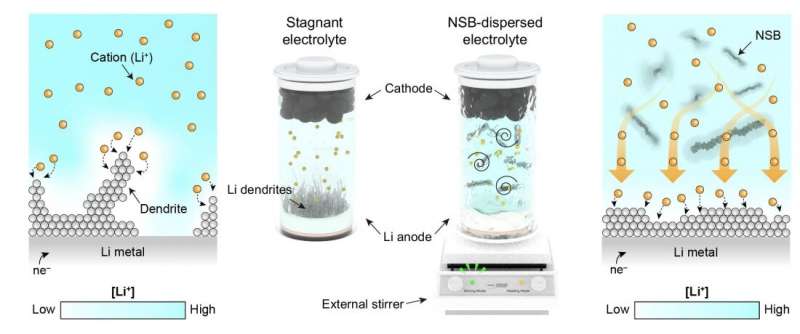Team overcomes obstacles to commercializing next-generation batteries by moving electrolytes remotely

A joint research team led by Professors Lee Hong-kyung, Lee Yong-min, and Lee Ho-chun of the Department of Energy Science and Engineering at Daegu Gyeongbuk Institute of Science and Technology (DGIST) has developed a new concept system that can dramatically improve the stability and lifespan of next-generation batteries.
It is expected to solve the problem of dendrite growth, which is a difficult problem in next-generation lithium metal batteries, by turning liquid electrolytes into a dynamic state, thereby accelerating the commercialization of next-generation batteries. The work is published in the journal Advanced Functional Materials.
Currently, most commercialized batteries, such as those in electric vehicles, use graphite electrodes as negative electrodes. A graphite negative electrode has limitations in terms of energy density because it is heavy and occupies a lot of space inside the battery. Since this limits long battery operation, the demand for a lighter and smaller anode material has been growing.
Lithium metal is in the limelight as a next-generation anode material that can solve these problems. However, commercializing lithium metal anodes is hindered by the generation of “dendrite,” a twig-shaped crystal that accumulates on the surface of the anode during the lithium battery charging process. This tends to be heavily dependent on the ion transport phenomenon in the electrolyte. In other words, when the ion transport velocity is faster and the homogeneity is improved, it is easier to control dendrite.
There have been consistent efforts to suppress dendrite, but it was ultimately necessary to break away from the classical ion transport method to come up with a faster and more homogeneous ion transport method.
The research team produced a nano-spinbar (NSB) that responds to an external magnetic field, so that the static electrolyte solution in the battery can be turned to a dynamic state, and added it to the electrolyte solution to generate micro-convection. In fact, it is possible to rotate NSBs distributed throughout the electrolyte by applying an external rotating magnetic field to transmit power remotely. This work facilitated fast ion transport while reducing ion diffusion by about 32% compared to the previous method, thus enabling homogeneous ion transportation.
The dynamic ion transport realized through the application of magnetic nanoparticles (NSB) and an external magnetic field can promote rapid and uniform transport of lithium ions, and it has been verified that it is effective in controlling dendrite formation and growth even at high charging rates. The same effect can be achieved when NSBs are added to other electrolytes. If a lithium metal battery is manufactured with the electrolyte developed by this research team and uses it while applying a rotating magnetic field on the outside, this will dramatically improve the battery’s lifespan compared to the existing system.
Professor Lee Hong-kyung of the Department of Energy Science and Engineering at DGIST said, “It is a new concept electrolyte system that can create a dynamic electrolyte that has never been attempted before and change the paradigm of electrolyte research through magnetic nanoparticles. It can be immediately applied to various electrochemical systems using liquid electrolytes.”
Asmat Ullah et al, Versatile Hole Selective Molecules Containing a Series of Heteroatoms as Self‐Assembled Monolayers for Efficient p‐i‐n Perovskite and Organic Solar Cells, Advanced Functional Materials (2022). DOI: 10.1002/adfm.202208793
Provided by
Daegu Gyeongbuk Institute of Science and Technology (DGIST)
Citation:
Team overcomes obstacles to commercializing next-generation batteries by moving electrolytes remotely (2022, December 15)
retrieved 15 December 2022
from https://techxplore.com/news/2022-12-team-obstacles-commercializing-next-generation-batteries.html
This document is subject to copyright. Apart from any fair dealing for the purpose of private study or research, no
part may be reproduced without the written permission. The content is provided for information purposes only.
For all the latest Technology News Click Here
For the latest news and updates, follow us on Google News.
